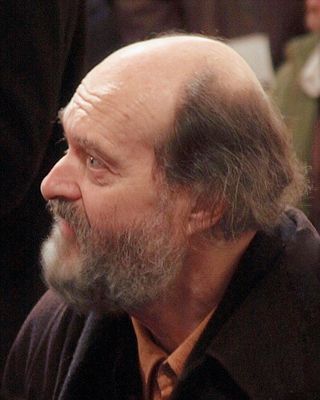
The viola ( vee-OH-lə, Italian:[ˈvjɔːla,viˈɔːla]) is a string instrument of the violin family, and is usually bowed when played. Violas are slightly larger than violins, and have a lower and deeper sound. Since the 18th century, it has been the middle or alto voice of the violin family, between the violin (which is tuned a perfect fifth higher) and the cello (which is tuned an octave lower). The strings from low to high are typically tuned to C3, G3, D4, and A4.

A string orchestra is an orchestra consisting solely of a string section made up of the bowed strings used in Western Classical music. The instruments of such an orchestra are most often the following: the violin, which is divided into first and second violin players, the viola, the cello, and usually, but not always, the double bass.

Henri François Joseph Vieuxtemps was a Belgian composer and violinist. He occupies an important place in the history of the violin as a prominent exponent of the Franco-Belgian violin school during the mid-19th century. He is also known for playing what is now known as the Vieuxtemps Guarneri del Gesù, a violin of superior workmanship.

Eine kleine Nachtmusik, K. 525, is a 1787 composition for a chamber ensemble by Wolfgang Amadeus Mozart (1756–1791). The German title means "a little night music". The work is written for an ensemble of two violins, viola, cello and double bass, but is often performed by string orchestras. The serenade is one of Mozart's most famous works.

The Symphony No. 94 in G major is the second of the twelve London symphonies written by Joseph Haydn. It is popularly known as the Surprise Symphony.
Joseph Clyde Schwantner is a Pulitzer Prize-winning American composer, educator and a member of the American Academy of Arts and Letters since 2002. He was awarded the 1970 Charles Ives Prize.
Antonín Dvořák's Serenade for Strings in E major, Op. 22 (B. 52), is one of the composer's most popular orchestral works. It was composed in just two weeks in May 1875.

The String Octet in E-flat major, Op. 20, MWV R 20, was written by the 16-year-old Felix Mendelssohn during the fall of 1825 and completed on October 15. Written for four violins, two violas, and two cellos, this work created a new chamber music genre. Conrad Wilson summarizes much of its reception ever since: "Its youthful verve, brilliance and perfection make it one of the miracles of nineteenth-century music." This was one of the first works of Mendelssohn to be very well received.
Nancy Dalberg was a Danish composer. Born into a wealthy family she studied under notable composers such as Johan Svendsen and Carl Nielsen, the later becoming a good friend and a significant figure in her life. Dalberg’s musical output is modest. In addition to the orchestral works mentioned, she wrote around fifty songs, including three for voice and orchestra.

Tabula Rasa is a musical composition written in 1977 by the Estonian composer Arvo Pärt. The piece contains two movements, "Ludus" and "Silentium," and is a double concerto for two solo violins, prepared piano, and chamber orchestra.

The Piano Quartet No. 3 in C minor, Op. 60, completed by Johannes Brahms in 1875, is scored for piano, violin, viola and cello. It is sometimes called the Werther Quartet after Goethe's The Sorrows of Young Werther. The premiere took place in Vienna on November 18, 1875, to an anxious public. Richard Wagner and his wife Cosima were in attendance.

The Piano Quartet No. 1 in G minor, Op. 25, was composed by Johannes Brahms between 1856 and 1861. It was premiered in 1861 in Hamburg, with Clara Schumann at the piano. It was also played in Vienna on 16 November 1862, with Brahms himself at the piano supported by members of the Hellmesberger Quartet. Like most piano quartets, it is scored for piano, violin, viola, and cello.
The Sonatina for Violin and Harpsichord is a three-movement, neoclassical chamber work composed by Walter Piston in 1945, that marks the beginning of his postwar style.
Jean François Toussaint Rogister was a Belgian virtuoso violist, teacher and composer.

The Gong on the Hook and Ladder or Firemen's Parade on Main Street, normally shortened as The Gong on the Hook and Ladder and also initially entitled Allegro moderato, is a short composition by American composer Charles Ives.

"Hymn: Largo cantabile", S. 84/1, sometimes also referred to as "Largo cantabile: Hymn" and often shortened as "Hymn", is a composition by American composer Charles Ives written in 1904. Grouped in the suite A Set of Three Short Pieces, it is published and commonly performed as a standalone work.

Tone Roads No. 1 is a short composition for chamber ensemble by American composer Charles Ives. It was finished in 1911.












